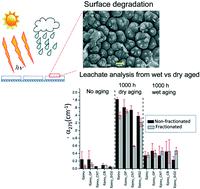当前位置:
X-MOL 学术
›
Environ. Sci.: Nano
›
论文详情
Our official English website, www.x-mol.net, welcomes your
feedback! (Note: you will need to create a separate account there.)
Fragmentation of polymer nanocomposites: modulation by dry and wet weathering, fractionation, and nanomaterial filler
Environmental Science: Nano ( IF 5.8 ) Pub Date : 2020-05-08 , DOI: 10.1039/c9en01360a Richard Zepp 1 , Emmanuel Ruggiero 2 , Brad Acrey 1, 3 , Mary J B Davis 1, 4 , Changseok Han 3, 5, 6 , Hsin-Se Hsieh 1, 4 , Klaus Vilsmeier 2 , Wendel Wohlleben 2 , Endalkachew Sahle-Demessie 5
Environmental Science: Nano ( IF 5.8 ) Pub Date : 2020-05-08 , DOI: 10.1039/c9en01360a Richard Zepp 1 , Emmanuel Ruggiero 2 , Brad Acrey 1, 3 , Mary J B Davis 1, 4 , Changseok Han 3, 5, 6 , Hsin-Se Hsieh 1, 4 , Klaus Vilsmeier 2 , Wendel Wohlleben 2 , Endalkachew Sahle-Demessie 5
Affiliation

|
In recent years, an increasing number of polymeric composites incorporating engineered nanomaterials (ENMs) have reached the market. Such nano-enabled products (NEPs) present enhanced performance through improved mechanical, thermal, UV protection, electrical, and gas barrier properties. However, little is known about how environmental weathering impacts ENM release, especially for high-tonnage NEPs like kaolin products, which have not been extensively examined by the scientific community. Here we study the simulated environmental weathering of different polymeric nanocomposites (epoxy, polyamide, polypropylene) filled with organic (multiwalled carbon nanotube, graphene, carbon black) and inorganic (WS2, SiO2, kaolin, Fe2O3, Cu-phthalocyanines) ENMs. Multiple techniques were employed by researchers at three laboratories to extensively evaluate the effect of weathering: ultraviolet-visible spectroscopy (UV-vis), Fourier transform infrared spectroscopy (FTIR), optical microscopy, contact angle measurements, gravimetric analysis, analytical ultracentrifugation (AUC), transmission electron microscopy (TEM), scanning electron microscopy (SEM) and Raman spectroscopy. This work aimed to elucidate the extent to which weathering protocol (i.e. wet vs. dry) and diverse filler characteristics modulate fragment release and polymer matrix degradation. In doing so, it expanded the established NanoRelease protocol, previously used for analyzing fragment emission, by evaluating two significant additions: (1) simulated weathering with rain events and (2) fractionation of sample leachate prior to analysis. Comparing different composite materials and protocols demonstrated that the polymer matrix is the most significant factor in NEP aging. Wet weathering is more realistic than dry weathering, but dry weathering seems to provide a more controlled release of material over wet. Wet weathering studies could be complicated by leaching, and the addition of a fractionation step can improve the quality of UV-vis measurements.
中文翻译:

聚合物纳米复合材料的破碎:干湿风化、分馏和纳米材料填料的调节
近年来,越来越多的含有工程纳米材料(ENM)的聚合物复合材料进入市场。此类纳米产品 (NEP) 通过改善机械、热、紫外线防护、电气和气体阻隔性能而呈现出增强的性能。然而,人们对环境风化如何影响 ENM 释放知之甚少,特别是对于高岭土产品等高吨位 NEP,科学界尚未对其进行广泛研究。在这里,我们研究了填充有机物(多壁碳纳米管、石墨烯、炭黑)和无机物(WS 2 、SiO 2 、高岭土、Fe 2 O 3 、Cu-酞菁)的不同聚合物纳米复合材料(环氧树脂、聚酰胺、聚丙烯)的模拟环境风化) ENM。三个实验室的研究人员采用多种技术来广泛评估风化的影响:紫外-可见光谱 (UV-vis)、傅里叶变换红外光谱 (FTIR)、光学显微镜、接触角测量、重量分析、分析超速离心 (AUC) 、透射电子显微镜(TEM)、扫描电子显微镜(SEM)和拉曼光谱。这项工作旨在阐明风化方案(即湿与干)和不同填料特性调节碎片释放和聚合物基质降解的程度。在此过程中,它通过评估两个重要的补充,扩展了先前用于分析碎片排放的已建立的 NanoRelease 协议:(1) 模拟降雨事件的风化和 (2) 在分析之前对样品渗滤液进行分馏。 比较不同的复合材料和方案表明,聚合物基体是 NEP 老化的最重要因素。湿风化比干风化更真实,但干风化似乎比湿风化更能控制材料的释放。湿风化研究可能因浸出而变得复杂,添加分馏步骤可以提高紫外-可见光测量的质量。
更新日期:2020-06-18
中文翻译:

聚合物纳米复合材料的破碎:干湿风化、分馏和纳米材料填料的调节
近年来,越来越多的含有工程纳米材料(ENM)的聚合物复合材料进入市场。此类纳米产品 (NEP) 通过改善机械、热、紫外线防护、电气和气体阻隔性能而呈现出增强的性能。然而,人们对环境风化如何影响 ENM 释放知之甚少,特别是对于高岭土产品等高吨位 NEP,科学界尚未对其进行广泛研究。在这里,我们研究了填充有机物(多壁碳纳米管、石墨烯、炭黑)和无机物(WS 2 、SiO 2 、高岭土、Fe 2 O 3 、Cu-酞菁)的不同聚合物纳米复合材料(环氧树脂、聚酰胺、聚丙烯)的模拟环境风化) ENM。三个实验室的研究人员采用多种技术来广泛评估风化的影响:紫外-可见光谱 (UV-vis)、傅里叶变换红外光谱 (FTIR)、光学显微镜、接触角测量、重量分析、分析超速离心 (AUC) 、透射电子显微镜(TEM)、扫描电子显微镜(SEM)和拉曼光谱。这项工作旨在阐明风化方案(即湿与干)和不同填料特性调节碎片释放和聚合物基质降解的程度。在此过程中,它通过评估两个重要的补充,扩展了先前用于分析碎片排放的已建立的 NanoRelease 协议:(1) 模拟降雨事件的风化和 (2) 在分析之前对样品渗滤液进行分馏。 比较不同的复合材料和方案表明,聚合物基体是 NEP 老化的最重要因素。湿风化比干风化更真实,但干风化似乎比湿风化更能控制材料的释放。湿风化研究可能因浸出而变得复杂,添加分馏步骤可以提高紫外-可见光测量的质量。









































 京公网安备 11010802027423号
京公网安备 11010802027423号